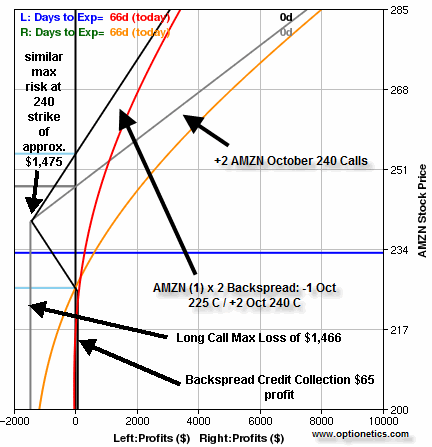
FIGURE 1: AMAZON BACKSPREAD VERSUS LONG CALL
Q&A

Got a question about options? Tom Gentile is the chief options strategist at Optionetics (www.optionetics.com), an education and publishing firm dedicated to teaching investors how to minimize their risk while maximizing profits using options. To submit a question, post it on the Stocks & Commodities website Message-Boards. Answers will be posted there, and selected questions will appear in future issues of S&C. Contributing analysis is by senior Optionetics strategist Chris Tyler.
DECLARE YOUR RIGHT TO EXERCISE
Recently, Apple delivered its first quarterly dividend in years. In front of the ex-date was considerable interest in the company’s calls, even by Apple standards. If someone is long the call, my understanding is he or she doesn’t collect the payout. Is that true? Open interest the next day didn’t reflect the massive activity. What happened?
You’re correct in recognizing a long call position forfeits its right to the dividend, but the heavy and lopsided volume [1.6 million contracts & P/C = 0.11] you’re referring to on August 8 was tied to a speculative overnight spread trade known as the dividend play, with the goal to capture the quarterly payout of $2.65 with deep buy-writes.
This strategy most commonly uses swapped verticals in an attempt to secure the desired deep buy-write position. Through the proper exercising of the vertical’s long calls into stock and a good deal of luck in keeping targeted short calls through the Option Clearing Corp.’s lottery-style assignment process, the trader can “capture the dividend” — establish a buy-write for $2.65 (minus any commission and holding costs).
To make this strategy work, there are two critical factors. First, traders will want to position in verticals whose short strike maintains a corresponding put market that’s less than the dividend. The greater the differential, the better it is for the trader on a risk basis. To capture the dividend is to open up the risk associated with a buy-write or short put. The second criterion is to have an existing pool of open interest. Why? The trader’s short calls from the paired-off verticals are now in this grouping with the purpose of remaining unassigned by traders already in the pool, forgetting or unwilling to exercise their long call contracts.
To illustrate, the regular August 555 and 560 calls both traded heavily and evenly with volume of around 22,000 apiece. Each option also sported decent pools of open interest of 2,300 and 3,300. The higher 560 strike put’s market value of just $0.33 was very attractive, relative to the potential $2.65 capture on any buy-writes that traders might escape with overnight. With those factors in place, not too far from the truth, the net action represented traders buying and selling verticals for $5.00 so they might have a shot at keeping a short call position on both strikes after exercising their long call contracts into long stock.
The next day, open interest was reduced on both strikes, but pools of about 750 and 500 contracts essentially meant $198,750 + $132,500, or a bit more than $330,000 was left on the table by long call holders not exercising their right to receive the $265 (per contract) dividend. In effect, the dividend was a gift to traders whose vertical’s short calls remained unassigned and were allowed to be converted into buy-writes worth the payout of $2.65. While this means the trader holds the equivalent risk of a short put, given the 560’s aforementioned price of $0.33 and midmarket close of $0.25 on the ex-date, that’s as close to a free lunch as we will find on Wall Street.
LONGING FOR A BACKSPREAD
If I’m bullish on a stock but wish to minimize my downside exposure when calls look cheap, could you suggest a spread that’s an alternative to buying calls?
When implied volatility is affordable, which we define in relation to its recent implied and underlying or statistical trading ranges and the trader maintains a directional bias, one unconventional position that might be suitable is the call backspread. A simple bull call vertical can always be approached when you’re looking to reduce risk, but the call backspread is potentially more attractive as the trader assumes a net long contract position in which a greater ratio of higher strike calls are purchased in relation to a lesser number of short calls on a lower strike with a typical set up being -1 x 2 contracts, -1 x 3 or -2 x 3.
Given a scenario of cheap premiums and the trader looking to minimize downside risk, the backspread enjoys both net long vega or volatility risk and typically a small credit or a much smaller debit than with buying calls or a bull call spread. Turning toward the first benefit, if implieds do rise, the backspread could stand to react profitably relative to the other strategies.
Second, if the trader is wrong about the direction of the underlying, the small credit can be captured at expiration if shares are below the sold strike and the entire backspread winds up out-of-the-money. If initiated for a modest debit, which will depend on strike distance, time to expiration, and implieds, that amount would be at risk but would be less than any considered long call or vertical positions. So what’s the downside? That rests on the ratio structure and assumed risk.
Figure 1 shows a simple comparison in Amazon (AMZN) from mid-August depicting a long call [+2 October 240 calls] position versus a backspread [-1 October 225 call/+2 October 240 calls], which maintain very similar maximum risk exposure at 240. This situation depicts the long call outperforming on the upside by virtue of its two long calls versus the backspread’s one, net long call. The long call position also has greater volatility exposure with its larger vega profile of two long contracts on the same strike as the backspread, but no short vega offset. However, the upside to owning the backspread, which can be considerable, is in a position to take in a small credit if conditions turn sour. And as we can see, that’s the downside of owning long calls.

FIGURE 1: AMAZON BACKSPREAD VERSUS LONG CALL